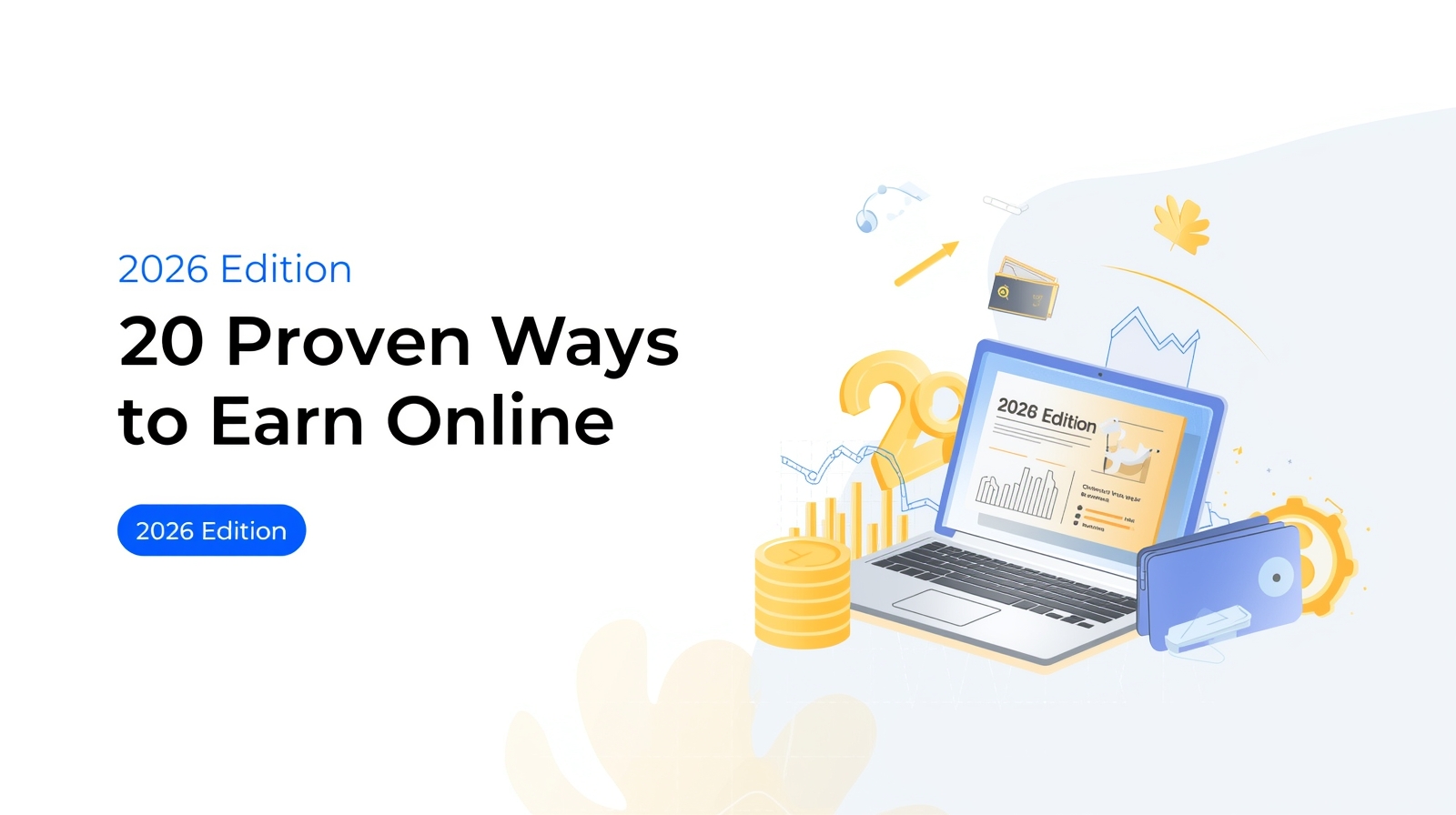1. Introduction — Why 2026 is an exciting time to make money online
Welcome to 2026 — where AI is a helpful (and sometimes sassy) sidekick, people prefer “subscribe to my brain” over ad-filled chaos, and global freelancing keeps growing like a potted plant that never stops. If you want to make money online, the landscape offers more paths than ever. The trick is picking one you’ll actually enjoy and then doing the boring, consistent stuff that turns small wins into steady income.
A few fast facts to set the scene: the freelancing and creator markets continue to expand, and new AI tools make certain tasks faster — but they also increase competition and change how value is delivered. (Sources: Upwork freelancing trends; creator platform growth; AI monetization guides.) Upwork+2Axios+2
2. Quick guide: How to choose the right path for you
Pick the path that sits at the intersection of:
-
What you can do (skills, experience),
-
What you enjoy (so you won’t burn out), and
-
What people will pay for.
If you’re unsure: start with freelancing small projects for real clients — it’s the fastest feedback loop. If you like building things with long-term value, think digital products or SaaS. If you enjoy performing and community, creator subscriptions might be your best fit.
3. Top 10 ways
Each method below includes: what it is, how to start, realistic earnings, pros & cons, quick tips, and tools/resources.
3.1 Freelancing & Remote Services
What it is: Sell your skills (writing, design, coding, marketing, video editing, voiceover, etc.) directly to clients worldwide via platforms or direct outreach.
How to start:
-
Pick a niche and 1–3 service offerings.
-
Create a simple portfolio (one-page site or portfolio on the platform).
-
Start with small jobs on marketplaces (Upwork, Fiverr, Freelancer) or reach out to local businesses.
-
Use proposals that solve one problem — not a resume dump.
Realistic earnings: From pocket money ($50/week) to full-time ($2,000–$10,000+/month) depending on skill level and niche. The freelancing market continues to grow strongly, with more people freelancing and increased demand for skilled contractors. Upwork+1
Pros: Fast start, low upfront cost, feedback from paying clients.
Cons: Income variability, client management overhead.
Quick tips:
-
Niches pay higher: e.g., conversion copywriting, Shopify dev, data engineering.
-
Offer a small fixed-price starter package for new clients.
-
Ask for testimonials and case studies.
Tools/Resources: Upwork, Fiverr, LinkedIn, simple portfolio site (Carrd, Webflow), Calendly, Stripe/Payoneer.
3.2 Creator Subscriptions & Memberships
What it is: Build a paying audience via subscriptions — newsletters (Substack), Patreon, channel memberships, or platform-native subscriptions (YouTube/IG/Twitter/Meta).
How to start: Choose a platform, package exclusive content (weekly deep dives, exclusive videos, direct access), and offer 2–3 pricing tiers.
Realistic earnings: Many creators earn modest amounts at first ($100–$1,000/month). Established creators with engaged audiences can scale to $5,000–$30,000+/month depending on niche and audience size. Recent platform interest and funding (e.g., Substack growth) show subscriptions remain viable for independent creators. Axios+1
Pros: Recurring revenue, direct fan relationships, creative freedom.
Cons: Requires audience building; churn is real.
Quick tips: Offer immediate value, run short promo challenges to convert followers to paid, and keep a free funnel (newsletter/social) feeding the paid tier.
Tools/Resources: Substack, Patreon, Memberful, Discord for community, email tools.
3.3 Affiliate Marketing
What it is: Promote other people’s products and earn a commission when people buy through your links. Works well with blogs, YouTube, newsletters, social posts.
How to start: Pick a niche, review or recommend products genuinely, create content that answers buyer questions, include affiliate links.
Realistic earnings: Very broad range — many beginners earn $0–$500/month; consistent bloggers and niche sites can earn $1,000–$20,000+/month. The affiliate marketing industry continues to grow and remains a powerful channel for online income. Hostinger+1
Pros: Scalable, passive once content ranks, low overhead.
Cons: Depends on traffic and conversion; platform rules & commissions change.
Quick tips: Focus on intent-driven content (buying guides, comparisons), disclose affiliations, diversify programs (Amazon, CJ, ShareASale, impact).
Tools/Resources: Ahrefs/SEMrush (paid), Google Search Console, affiliate networks (CJ, Impact, Awin), link management (PrettyLinks, Bitly).
3.4 Selling Digital Products (Courses, Templates, Presets)
What it is: Create downloadable products — e-courses, templates, Excel models, Lightroom presets, design templates — and sell them repeatedly.
How to start: Validate with a small beta or pre-sale. Use a landing page, email list, and social proof.
Realistic earnings: From a few hundred dollars per month to $10k+/month for high-value courses with paid ads. Low ongoing cost after creation.
Pros: Highly scalable, passive after initial work.
Cons: Upfront creation time and marketing effort.
Quick tips: Start with a micro-course (a focused 1–2 hour course). Price tests: $19–$199 for small courses; $499+ for high-value cohort programs.
Tools/Resources: Gumroad, Teachable, Thinkific, Podia, Stripe, Canva, Loom.
3.5 E-commerce + Dropshipping + Print on Demand
What it is: Sell physical goods online. Dropshipping means suppliers ship orders directly; print-on-demand prints your designs when someone orders.
How to start: Pick product niche, validate via low ad spend or social proof, build a Shopify store or sell on Etsy/Amazon.
Realistic earnings: Many shops fail early; realistic small stores: $500–$5,000/month. Winners scale to $10k–$100k+/month with strong branding.
Pros: Potentially large upside, direct control over brand.
Cons: Inventory/fulfillment complexity (except dropshipping/POD), ad costs.
Quick tips: Focus on branded stores and email retargeting. Use POD for low risk. Avoid saturated generic products.
Tools/Resources: Shopify, Oberlo/DSers, Printful, Etsy, Amazon FBA, Facebook/Meta Ads, Google Shopping.
3.6 AI Services & Micro-SaaS
What it is: Offer AI-powered services (custom chatbots, content automation, image generation) or build small subscription software that solves a narrow problem.
How to start: Identify repetitive tasks people pay to automate. Build a simple product using AI APIs or combine existing tools into a paid workflow.
Realistic earnings: Micro-SaaS can bring $100–$10,000+/month depending on niche and product-market fit. Offering AI services freelancing can easily command premium rates.
Pros: High margins, recurring subscriptions.
Cons: Technical overhead or vendor dependence; product maintenance.
Quick tips: Solve a specific problem (e.g., automating follow-ups for small businesses) and price transparently.
Tools/Resources: OpenAI API / other LLMs, Bubble (no-code), Stripe for billing, Heroku / Vercel for hosting.
(Industry interest in AI monetization is strong — see practical guides showing many monetizable AI ideas for 2026.) Shopify
3.7 Content Monetization (Ads, Sponsorships, Native Commerce)
What it is: Earn from content via display ads (AdSense), sponsored posts, or integrated commerce (shoppable content).
How to start: Build good content, reach threshold for ads or pitch brands for sponsorships.
Realistic earnings: Small blogs: $50–$500/month on ads; mid-size creators can get thousands from sponsorships. Ad markets are shifting (digital ad growth and AI changes affect budgets), so diversify income sources. Reuters
Pros: Passive ad revenue, brand deals can pay well.
Cons: Ad income fluctuates with ad market; requires traffic.
Quick tips: Niche content with high commercial intent (finance, software, health) pays better in CPMs and sponsorships.
Tools/Resources: Google AdSense, Mediavine, AdThrive (if eligible), SponsorPitch, G-Suite for pitches.
3.8 Online Tutoring & Coaching
What it is: Teach skills (language, coding, music) or coach (business, life, fitness) one-on-one or group formats.
How to start: Create a clear offer, set hourly or package pricing, use Calendly and Zoom, collect testimonials.
Realistic earnings: Tutors: $10–$50+/hour (language); coaches: $50–$500+/hour depending on specialization.
Pros: Immediate cash flow and client feedback.
Cons: Time-for-money model unless packaged into scalable group formats.
Quick tips: Convert 1:1 clients into group programs for scale.
Tools/Resources: Preply, iTalki, Teachable, Zoom, Stripe, Calendly.
3.9 Microtasks, Gig Platforms & Niche Marketplaces
What it is: Short tasks (data labeling, micro-jobs, transcription) and specialized marketplaces (stock photos, micro-services).
How to start: Sign up on platforms (Appen, Amazon Mechanical Turk, Upwork for micro-gigs) and focus on higher-paying gigs.
Realistic earnings: Usually low per task; good for top-ups, learning, or quick cash — not ideal for long-term scaling.
Pros: Easy entry, flexible.
Cons: Low pay per hour on many microtask platforms.
Quick tips: Use microtasks as bridge income while building higher-value assets.
Tools/Resources: Appen, MTurk, Clickworker, Shutterstock, Adobe Stock.
3.10 Investing & Passive Income Online (crypto caution, index funds, P2P)
What it is: Earning through investing in assets accessible online — stocks, index funds, P2P lending, crypto (risky).
How to start: Learn the basics, use low-cost index funds for passive wealth building, treat crypto as speculative, and never invest money you can’t afford to lose.
Realistic earnings: Long-term stock market returns average historically ~6–8% real annual return; crypto can be extreme — both high reward and high risk.
Pros: Truly passive after setup (for index funds).
Cons: Risk, market volatility, scams in some P2P/crypto platforms.
Quick tips: Dollar-cost average, use ETFs, and diversify. Get local tax/legality advice.
4. Picking a business model and the minimum viable plan (30-day action plan)
Pick one method. Don’t multitask until you have traction. Here’s a simple 30-day plan for starting (example: freelancing or creator path):
Days 1–7: Validate & set up
-
Choose niche and 1-page offer
-
Create portfolio/landing page
-
Set pricing and 2-tier package
Days 8–14: Create lead content
-
Publish 3 useful pieces (blog, video, or LinkedIn posts)
-
Set up email capture
Days 15–21: Outreach & small tests
-
Pitch 10 clients or promote to 100 followers
-
Run a tiny paid test (Facebook/Meta or sponsored post) if budget allows
Days 22–30: Improve & close
-
Refine offers from feedback
-
Close first paid client or 10 subscribers
-
Document processes (templates, scripts)
Repeat monthly: focus 80% on promotion, 20% on product creation.
5. Tools checklist — free & paid tools to get started quickly
-
Website/landing: Carrd, Webflow, WordPress
-
Payments: Stripe, PayPal, Payoneer
-
Email: MailerLite (free tier), Substack (for newsletters)
-
Marketplaces: Upwork, Fiverr, Etsy, Shopify
-
SEO & research: Google Search Console, Ubersuggest (starter), Ahrefs (paid)
-
AI helpers: GPT tools for drafts, Midjourney/stable diffusion for images (use ethically)
-
Scheduling: Calendly, Google Calendar
6. SEO, promotion, and compounding growth — simple strategies that work
-
Write content that answers buyer questions. People search before they buy.
-
Repurpose a single piece of content into a thread, short video, newsletter, and blog.
-
Email is gold. Capture email from day one and nurture it.
-
Be consistent and measurable. Post schedule + one performance metric to track.
7. Common mistakes and how to avoid them
-
Mistake: Chasing every shiny trend.
Fix: Pick one thing and do it for 6 months. -
Mistake: Pricing too low.
Fix: Start fair; raise prices and add value. -
Mistake: Ignoring legal/tax rules.
Fix: Set aside a tax buffer; consult local regulations.
8. Short FAQ
Q: Which method is fastest to get paid?
A: Freelancing or tutoring — you can get clients and payments within days or weeks.
Q: Which is most passive?
A: Digital products and indexed investments are the most passive once set up.
Q: How do I avoid scams?
A: Stick to reputable platforms, don’t pay to apply for jobs, and vet opportunities.
9. Final pep talk & next steps (one-page action list)
-
Pick 1 path and niche today.
-
Build a one-page offer and share it with 10 people.
-
Create 3 pieces of value content this week.
-
Collect emails and offer a small paid test product.
-
Track your results and iterate.
You’ve got options. The most important part is not picking the perfect path — it’s starting and learning quickly. Remember: small, consistent actions beat occasional huge efforts.

Selected sources for key claims
-
Freelancing growth and stats (Upwork resources). Upwork
-
Substack / creator subscriptions / funding and creator growth. Axios
-
Affiliate market size and 2025 trends. Hostinger+1
-
Practical AI-to-income guides (shopify ideas 2026). Shopify
-
Digital ad market outlook and AI in advertising (WPP / Reuters). Reuters


